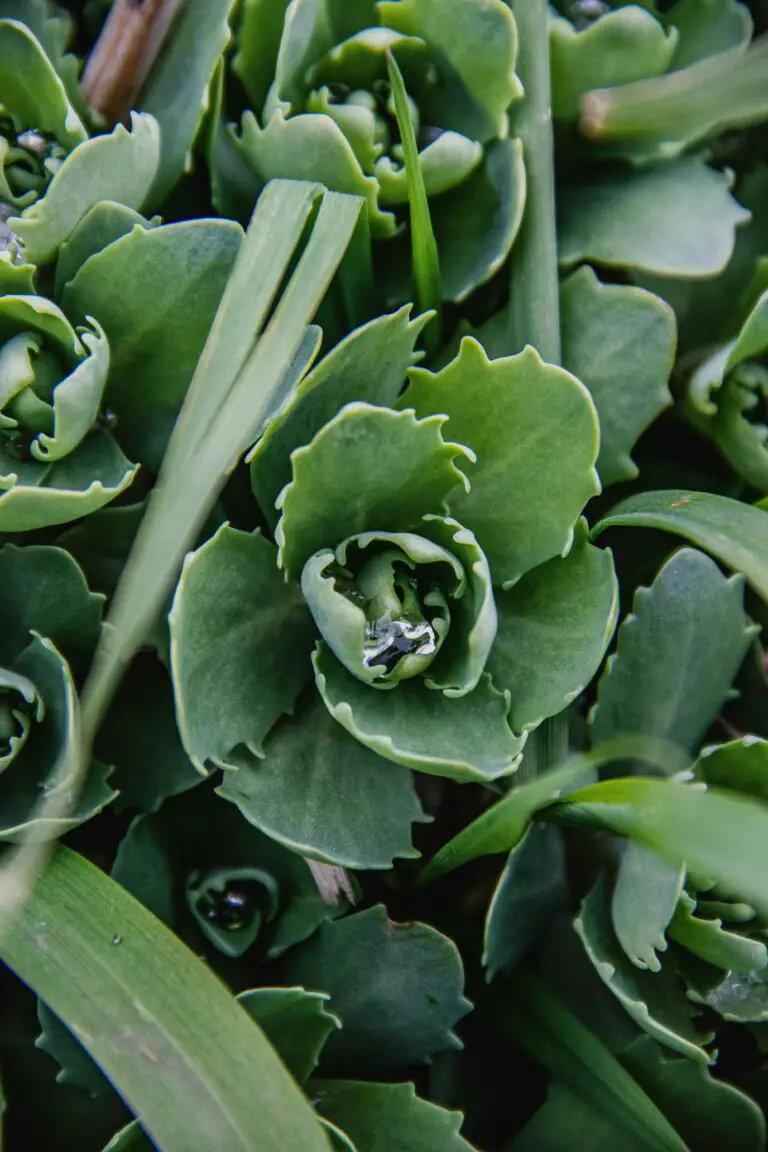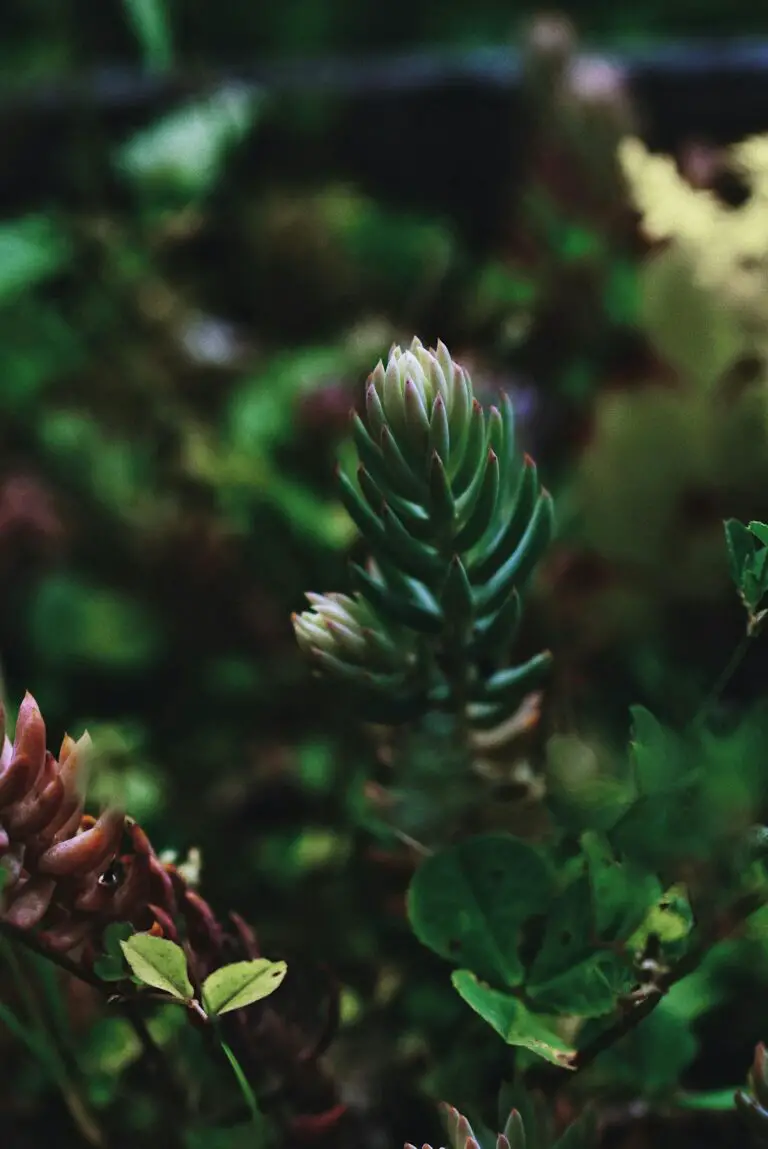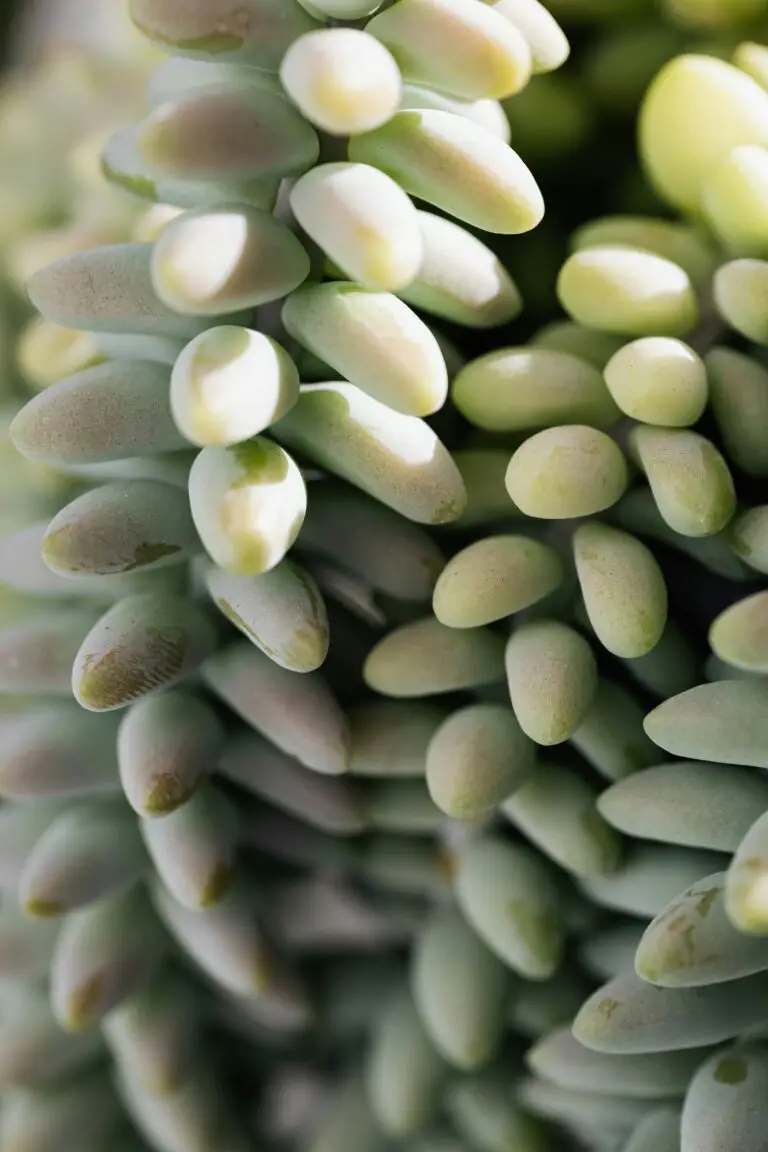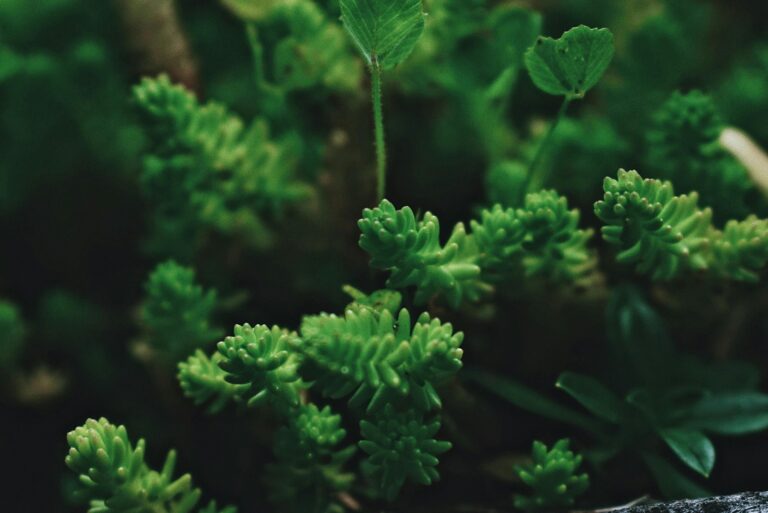Introduction to Sedum Planting in the UK
Embarking on a gardening adventure with sedums in the UK invites an irresistible blend of versatility and resilience to your green sanctuary. Picture this: a kaleidoscope of sedum species effortlessly weaving their succulent leaves through your garden tapestry, each one as adaptable to the UK’s fickle climate as the next. We’re not just talking about any ordinary plants; these are sedums, the hardy succulents that laugh in the face of chilly breezes and thrive amidst the balmy British summers.
Imagine the sedum’s plump, water-storing leaves capturing beads of rain, like nature’s own meticulously crafted water globes. You’ll find sedums dotting coastal cliffs, cheerfully sprouting between rocky crags, and adding bursts of life to arid spots where other plants would simply wilt. This is the robust spirit of sedums that makes them coveted jewels in the UK’s garden crown. Some gardens even feature them encircling serene ponds, juxtaposing their vibrant greenery against the still, mirror-like water.
Their adaptability is legendary; they are the thriving underdogs in a world where delicate florae often take center stage. It’s a testament to their tenacity when you witness sedums adding their energy to the classic English garden scene. And beyond the charm, they bring forth tangible benefits. Envision a low-maintenance utopia where sedums are working around the clock, fortifying your garden’s defenses against drought while playing a pivotal role in conserving water.
The beauty of a sedum is not just in its thick, fleshy leaves but in its ability to enhance biodiversity. When these succulents bloom, they become a beacon for pollinators, their tops abuzz with the activity of bees and butterflies. By introducing sedums to your patch of the earth, you’re not merely planting a garden, you’re cultivating a refuge for winged visitors and a haven for your own peace of mind.
Let’s not forget their seasonal spectacle either. As fall dawns, sedums transition from lush green to burnished hues of autumn, a visual feast for the eyes and a reminder of nature’s cycles. At this moment, a sedum-laden garden evolves into a living canvas, painted with strokes of rusts, golds, and deep reds—the quintessential autumnal palette.

And so, as we consider the rolling landscapes and the diverse climates of the UK, it is clear that sedums are not just surviving—they are thriving, cementing their place as a garden mainstay. Whether nestled in a rock garden, sprawled across a rooftop, or accentuating a herbaceous border, sedums prove that sometimes, the most unlikely candidates turn out to be the heroes of horticulture. It’s high time to make room in our gardens for these rugged beauties and watch them transform our green spaces into an oasis of strength and splendor.
Understanding Sedum’s Habitat Preferences
Have you ever wondered why sedum plants, those versatile little survivors of the succulent world, are such a hit in UK gardens? Well, it’s all about mimicking their natural habitat to give them that sweet spot where they can bask in glory. Here’s a hint: these plants are no fans of being cosseted. In the wild, sedum thrives on neglect, basking in the full sun, their roots gripping onto rocky outcrops like climbers scaling a cliff. That’s right, these hardy plants relish conditions that would make other plants wave the white flag.
Now picture this: you’re about to embark on creating a lush, sedum-filled garden, right here in the UK. Picture a sunny spot, perhaps a south-facing slope, a roof garden, or even a rockery. This is where your sedum can play out its ‘sun worshipper’ dreams to the fullest. In fact, I’ve seen sedum growing with undeterred zest on the gravelly paths of the majestic Inveraray Castle grounds in Scotland, flaunting their fleshy leaves and starry blooms as if to say, “We’ve got this!”.
But let’s highlight drainage – it’s non-negotiable. Sedum’s disdain for soggy feet is palpable. Have you ever stumbled upon a sedum thriving on a neglected, crumbly wall? That’s drainage perfection! In the UK, packing your planting area with gritty sand or gravel creates an environment that sedum plants find irresistible – it’s like recreating their own little piece of alpine paradise.
And if you’re looking to learn more about sculpting your succulent heaven, including these plucky little sedums, our comprehensive guide is just the ticket to success. It’s a tale of less pampering and more understanding, letting these hardy sedums spread their roots and stand proud against the backdrop of your garden tapestry. So roll up your sleeves and let’s get planting!
Remember, to truly appreciate what makes sedum dance with joy in your garden, think about their rugged, unpolished background and try to mirror that. It’s not just about planting a sedum; it’s about crafting a home where sedum feels… well, at home! So now that we’ve peeked into the world of sedum’s habitat preferences, it’s time to get creative and let these natural wonders thrive.

Selecting the Right Sedum Variety for Your Garden
Picture this: A sun-soaked garden erupting with vibrant sedums, each fitting snugly into its own special niche, whether it’s a rooftop garden in the bustling city or a quaint cottage border in the gentle countryside. Sedums, also known as stonecrops, are the versatile heroes of the plant world, thriving in the varied landscapes of the UK with a somewhat nonchalant grace.
Now, let’s dive into the verdant world of sedums and uncover the ideal varieties for your garden theatre. The UK climate is a patchwork of conditions — while some areas revel in the mild maritime influence, others are exposed to the brisk winds and chills. It is crucial to select a sedum variety that not only enchants with its beauty but also endures the local dance of the elements.
For the sun-worshippers of the South, where warmth lingers and frosts are a rarity, the ‘Matrona’ with its statuesque form and dusky pink blooms is a show-stopper. Or perhaps the ‘Cape Blanco’, silver and sculptural, defies the salty sea breezes of coastal regions with impeccable poise.
Heading North, where the whispers of winter linger longer, ‘Purple Emperor’ emerges with a promise of resilience, its deep burgundy leaves a stark contrast against snowy backdrops. In shaded nooks where the sun shyly peeks, the lovely ‘Fulda Glow’ presents its ruby-red kiss to the dappled light.
It’s not all about looks though — regional weather patterns beckon for attention too. The plush ‘Autumn Joy’ sedum, with its water-wise ways, is tailor-made for the occasional droughts and sweltering spikes in the Southeast. Conversely, in the rain-drenched realms of the Northwest, the steadfast ‘Thundercloud’, compact and tight, holds firm against the relentless downpours.
Enthusiastic gardeners speak fondly of personal experiments where a seemingly tender sedum variety defies the odds, lending a dash of rebellion to your green space. However, there’s wisdom in heeding the whispers of the environment when making your choice.
Yearning for more guidance on crafting your personal sedum haven? You’ll relish the insights shared in our detailed sedum planting guide, offering step-by-step wisdom to ensure your succulents don’t just survive, but truly thrive.
Embarking on the quest for the perfect sedum is not merely a guesswork game. It’s about understanding your garden’s microclimate, listening to the murmurs of the winds, the tales of the sun’s path, and the rhythm of the rains. With such knowledge snug in your gardener’s pocket, the sedums you select won’t just grow; they’ll perform an exquisite ballet, gracing your garden with a resilience and splendor that speaks of your thoughtful choreography.
Preparing the Ideal Soil for Sedum
Let’s get down and dirty and talk about what really matters when prepping the perfect spot for your sedum – the soil! It’s the secret sauce to a glorious, succulent garden. Now, before visions of vibrant sedum gardens start dancing in your head, remember, it all begins beneath the surface. You might not be a soil sommelier, but with a little know-how, you’ll be pairing your sedum with the ideal earthy mix like a pro.
First things first, understand that sedums are not picky divas, but they do have a type. They crave well-draining soil, the kind that makes water run through it faster than gossip in a small town. This means getting familiar with the land you’re working with. From the dense clay of Devon to the sandy shores of Suffolk, your mission is to create a balanced mix that allows roots to breathe while holding onto just enough moisture for those succulents to sip on.
Here’s where you become the mix master. Amend your native soil with generosity, folding in organic matter like well-rotted compost or aged manure. It’s like giving your sedums a five-star meal – indulge them! But don’t stop there. Summon the gritty allies – sharp sand, perlite, or fine gravel – to enhance drainage. Nobody likes wet feet, especially not sedums, and that extra grit will keep things airy and light.
Picture this: you’ve just mixed the ultimate sedum substrate. The texture? As crumbly as your favorite shortbread. Now imagine tucking those resilient sedum babies into their beds, knowing you’ve set the stage for an epic growth spurt. And hey, don’t forget caring for your sedum once it’s in the ground – it’s a continuous journey.
Remember, the key to sedum success starts below the surface. Tailor that soil to suit their needs, and you’ll have healthy, happy sedums that bolster your garden’s charm. Just like the sedum, you can be sturdy and adaptable in how you prepare your plots, ensuring thriving greenery regardless of the unpredictable British weather!

Choosing the Perfect Spot: Sunlight and Shade Considerations
When you’re plotting out where to plant sedum in your UK garden, envisioning the lush, vibrant succulents basking in the perfect balance of sunlight and shade is key. Sedum, also known as stonecrop, isn’t just a plant—it’s a sun worshipper that thrives with ample rays. But don’t be fooled; this hearty botanic can also tolerate those dappled shade nooks that other plants might shy away from.
Imagine a typical British day, with the sun playing hide and seek behind the clouds. Sedum plants are the ideal contenders for this game, able to soak up intermittent sunshine while weathering the overcast spells. In fact, sedum embodies a unique duality—it adores the sunshine but doesn’t whimper at the first sign of cloud cover. This makes picking the right spot something of a strategic move rather than a wild guess.
Real-life examples sprinkle across flourishing UK gardens: sedum varieties like ‘Autumn Joy’ basking in south-facing borders or ‘Cape Blanco’ nestling in that sunny patch beside the garden shed. Each has found its niche, embracing either the unabashed sunlight or the cooler reprieve of shade.
When you’re surveying your outdoor space, consider areas where the sun lingers for at least six hours. Sedum is akin to a solar panel, the longer it can bask, the more energy it has to unfurl those succulent leaves and burst into starry blooms. It’s a photophilic phenomenon that illustrates nature’s fine-tuned adaptation. However, if your garden is more shaded, fret not. Sedum will still flourish in partial shade, allowing you to dot these hardy jewels around the understory of taller plants or in the shadow of a garden wall.

To encapsulate, when deciding where to plant sedum in the UK, consider both full sun and partial shade locals as your canvas. Let’s make those succulent dreams a reality and create a sedum garden that not only survives but thrives.
Companion Planting with Sedum
Imagine a succulent garden where every plant complements the others, bringing out the best in each other. That’s the art of companion planting with sedum—a practice as old as gardening itself and one that could transform your UK green space into a thriving ecosystem. But what exactly makes a good companion plant for your sedum?
Firstly, let’s consider the easy-going nature of sedum. These hardy succulents are drought-resistant and love the sun, just like lavender, which doesn’t just share the same needs but can bring a buzz of pollinators to your garden. Now picture the upright spikes of lavender brushing against the lush, spreading foliage of sedum—both aesthetically pleasing and practical!
Grasses are another group of plants that make great companions for sedum, blending texture and movement. Ornamental grasses like fescue or blue oat grass can create soft backdrops for the sculptural forms of sedum. They sway in the breeze, providing a dynamic contrast to the firm, composed sedum at their feet.
Tried-and-True Sedum Sidekicks
Now, let’s dive into some real-life scenarios. Ever heard of the ‘green roof’ at the Musée du Quai Branly in Paris? Sedum roofs are a hit because sedum thrives with minimal soil – an excellent trait for urban green spaces. Planting sedum with sempervivum, also known as houseleeks, can mimic these green roofs in your garden. Both plants are succulents that form tight clusters of rosettes, offering a visually striking and low-maintenance ground cover.
For the cottage garden fans, combine your sedum with flowering perennials like coneflowers or catmint. The sedum serves as a lush, verdant base while the coneflower’s tall, striking blooms rise above, and the catmint adds a gentle sprawl of color at the front. It’s a tiered approach to garden design, where sedum forms a dependable, evergreen foundation.
And let’s not forget the humble herbs. Thyme, which crawls across the garden floor with tiny, aromatic leaves, can nestle in nicely alongside sedum. This partnership not only conserves space and resources but also adds a sensory pleasure to your gardening experience. Just brush your hand against the thyme and enjoy the fragrance that complements the visual beauty of sedum.
Last but not least, here’s a visual treat for you. Watch this insightful video on companion planting to get the creative juices flowing and visualize the endless possibilities for your sedum companions:
As we explore companion planting for sedum in the UK, the key takeaway is looking for plants that share similar needs but bring different attributes to the table—be it aesthetics, attracting wildlife, or enhancing garden health. Whether it’s the silver foliage of lavender, the rustling whispers of ornamental grasses, or the symmetrical rosettes of sempervivum, each companion plant has a role to play in your sedum story.
Seasonal Care for Sedum in the UK
For all the green thumbs and succulent enthusiasts, dialing in the right seasonal care for your sedum will make all the difference. Let’s take a stroll through the calendar year of a UK sedum plant, shall we?
Spring Awakening
As the British winter frost recedes and the first daffodils dare to poke through the soil, it’s time for your sedum to shine. In spring, focus on selecting a sunny spot where your succulent can wake up and stretch its leaves. Sedums crave light after the long dark, and a southerly exposure will give them the pep in their step. Now is also the time to clear any winter debris and consider a light feeding with a low-nitrogen fertilizer to encourage strong growth.
Summer’s Bounty
Fast forward to summer, your sedum is likely in full superhero mode—vibrant and vigorous. The key here is to make sure they’re not sweltering. While they love sunshine, a scorching midday sun can cause sunburn (yes, plants get it too!). If we’re in for a typical British summer, though, you’ll likely just need to ensure they don’t sit in soggy soil after a thunderstorm—sedum roots despise a soggy bottom.
Autumn Adjustments
Autumn paints the countryside with rich, ambery tones, and your sedum might start to show off its fall colors as well. It’s time to reduce watering and let your plants harden off in preparation for cooler weather. Remove any fallen leaves that might smother your sedum and trim back any leggy growth. This will help prevent rot and keep your garden looking tidy.
Winter Watch
As we round off the year, winter care takes a front seat. Sedum plants are generally hardy, but a sneaky cold snap can catch even the hardiest succulent off guard. Shield your sedum with a dry mulch, like straw or wood chips, to protect its roots from freezing. Remember, wet soil is more likely to freeze, so ensuring good drainage is vital.
Through every season, taking care of sedum is about balance—balance of sunlight, water, and protection. Like Brits queuing for the bus, they appreciate their space, detest being waterlogged, and relish a sunny day. Stay attentive to these needs, and your sedum will reward you with robust health and a dazzling display year-round.

Troubleshooting Common Sedum Problems
Gardeners, assemble! It’s time to turn your sedum sorrows into succulent successes. But first, let’s address the green elephant in the room: common issues that may besiege your sedum plants in the lush but unpredictable UK climate. We’re shining a botanical spotlight on pests, diseases, and weather damage that target your fleshy foliage friends.

It’s Not Just “Bug” Soup — Let’s talk uninvited guests. Whether it’s aphids conspiring on new growth, or mealybugs hiding under leafy havens, these pesky critters can sap the life out of sedums quicker than you can say “not in my backyard!” The solution? Embrace your inner garden detective. Inspect regularly, and introduce beneficial insects, like ladybirds, that treat these pests as their next meal.
Mold and Rot, Begone! — Consider sedum the Goldilocks of succulents; they adore well-drained soil. Too much moisture and you’ll find an invitation for fungal foes like root rot. Next thing you know, your plants start mirroring the grey UK skies above. Cut back on water, ensure proper drainage, and remember, your sedum’s roots treasure breathing space as much as you cherish a fresh spring breeze.
Sedum and the Sunbeam Saga — When the sun decides to grace the UK with its presence, sedum basks in the glory. However, the same sunny smile that warms your soul can scorch your beloved sedums if they’re not accustomed. Gradual introduction to full sun prevents a plant tan turning into a sunburn. It’s all about that perfect tan, isn’t it?
The Frost Alert — UK winters can show up unannounced, swinging temperatures like a pendulum. Hardy though they may be, sedums are not fans of frostbite. Provide mulch as a cozy blanket, and when Jack Frost is knocking, perhaps relocate potted pals to a more comforting spot. A little TLC ensures your sedums survive not just a cold spell, but a whole wizard’s winter.
Armed with this advice, you can keep your sedum looking not just surviving but thriving. So the next time your sedum sends out an SOS, you’ll wave back with a green thumb that’s schooled in the art of plant-first aid. Onwards, to a flourishing sedum sanctuary!
Conservation and Environmental Impact of Growing Sedum
Planting sedum in the UK isn’t just about creating an attractive garden space; it’s a positive step for conservation and biodiversity. The tough yet beautiful sedum species are incredible warriors in the fight for a healthier ecosystem, encouraging a rich tapestry of life even in the most compact city gardens.

Like a well-trained army for conservation, these charming succulents offer a lifeline to pollinators. Bees, butterflies, and other beneficial insects are drawn to the sedum’s vivid blooms, basking in a nectar-rich habitat. Picture this: a buzzing bee hotel, alive with the gentle hum of hard workers, fueled by your sedum sanctuary.
The Biodiversity Boost
By choosing to include sedum in your little slice of the outdoors, you’re voting for biodiversity. You’re inviting an array of insects, each playing a unique role in the balance of nature. In turn, these insects support local bird populations, who feast on them, chaining a link of life from the ground up. Sedum isn’t just a plant; it’s a foundation stone in the ecological building.
The Green, Not So Mean, CO2 Machine
And let’s not forget, every leaf and stem is a silent warrior against climate change. Sedums, in their quiet existence, are carbon-consuming heroes. With their easy-going nature, they don’t demand much but give back plenty, soaking up carbon dioxide and breathing out life-giving oxygen. The more greenery we have, the more we combat the invisible enemy of excessive CO2 in our atmosphere.
You don’t need a countryside expanse to make a difference. Even the smallest sedum-spotted balcony can host its own mini-conservation project. Starting a green revolution from your doorstep – that’s the sedum spirit. With every patch of UK soil claimed by sedum, you’re stitching together a natural quilt of habitats and hope for the future of our planet.
Summing Up: Making Sedum a Star in Your UK Garden
When it comes to uncomplicated gardening with a payoff that spans the seasons, sedum plants take the spotlight. Hailed for their hardiness and aesthetic versatility, these succulent treasures can transform your outdoor space into an enduring haven of texture and colour. In the UK, where gardens are often at the mercy of unpredictable weather, sedum stands as an unwavering protagonist against the elements.
Imagine a winter scene, frost etching its silver filigree across the garden—the skeletal forms of deciduous shrubs laid bare. Amidst this, the robust sedum remains evergreen, its fleshy leaves holding onto life, a reminder of the resilience found in nature. This promises steadfast year-round interest for any British garden, making it a gardener’s trusted companion through each season.
Summer paints a different picture; sedum bursts into starry blooms, attracting bees and butterflies in a bustling display of wildlife affinity. Envision your garden abuzz with activity, an eco-centric hotspot nestled in the heart of the UK. It’s not just about the visual splendour—your garden becomes a conversation piece, a micro-habitat for local fauna, all through the simple act of planting sedum in the right spots.
Let’s not forget the sheer simplicity of caring for sedum. These plants ask very little of us—just a sunny corner and well-drained soil. Even the most novice of gardeners in the UK can boast success with sedum. In a nation known for its keen gardeners, sedum allows everyone to participate and enjoy the perks of horticulture without the laborious toil.
By now, it’s clear that sedum is not just a plant—it’s a statement. It’s an emblem of low maintenance, durability, and four-season charm. Now, imagine looking out of your window to a landscape punctuated with sedum’s rich hues and knowing that this effortless beauty is an achievable dream in the heart of the UK.

Incorporating sedum into your UK garden is more than a gardening choice—it’s a commitment to a lifestyle that values ease and rewards with perpetual beauty. Whether you fashion carpets of groundcover or clumps that accent rockeries and borders, sedum will fit your garden narrative, thriving with minimal fuss. It’s a gardener’s delight, a little piece of nature’s wonder, ready to make your outdoor space a standout sanctuary.
Frequently Asked Questions
Curious about creating an oasis of succulents in your UK garden? You’re not alone! The resilient and diverse sedum has caught the eye of many green-thumbed enthusiasts looking for that perfect blend of beauty and low-maintenance gardening. So, let’s dive into some welly-to-earth wisdom and unearth the secrets to sedum success in the UK!
What’s the Best Spot to Plant Sedum in my UK Garden?
Picture this: a sun-drenched rockery or a charming gravel path lined with the vibrant hues of sedum. These succulents crave sunlight, so choose a spot where daylight is generous. A south-facing garden is the sedum’s slice of heaven, basking in the sun’s glow for the better part of the day. Sedums are not just sun worshippers, though; they’re also tough cookies when it comes to soil. They prefer well-drained soil—think the sandy haven of a coastal garden, where they can flaunt their drought-tolerant superpowers.
Can Sedum Survive the Not-so-tropical UK Winters?
Indeed they can! Sedum is as robust as a Brit braving the rain without a brolly. Many sedum varieties, such as the beloved ‘Autumn Joy’, have adapted to the UK’s cooler conditions. They can withstand frost and even snow, making a comeback every spring as if they’d never left the party. Plant them in raised beds or on a slope, and they’ll shrug off winter’s chill like snow off a greenhouse roof.
How Do I Keep my Sedum Happy and Blooming?
Imagine you’re at a garden party, and the sedums are the illustrious guests. They don’t ask for much – just a sunny spot and a sip of water during extreme drought. Plus, a bit of pruning in early spring can encourage thicker growth and more blooms. Think of it as giving your sedums a fresh haircut for the new season. It keeps them perky and ready to show off their succulent splendor.
Now, let’s get a visual treat with a hands-on demonstration on propagating sedums, ensuring your garden remains a lush, verdant paradise. Watch and learn as we delve into the art of sedum propagation:
Remember, whether you’re a seasoned gardener or a budding novice, the sedum is your amiable ally in the quest for a fuss-free yet striking garden vignette. So, don your gardening gloves, and let’s plant a scene that even your neighbors will be talking about!


